

According to foreign media reports, the Swiss Federal Laboratories for Materials Science and Technology (EMPA) and the University of Geneva (U
According to foreign media reports, researchers from the Swiss Federal Laboratories for Materials Science and Technology (EMPA) and the University of Geneva (UNIGE) in Switzerland have designed a new all-solid-state battery sample that can store More power while ensuring battery safety and reliability. In addition, the battery uses sodium as a cheap alternative to lithium.
The normal operation of the battery is closely related to the following three components: anode (negative electrode), cathode (positive electrode) and electrolyte (electrolyte). The batteries used in today's electronic devices are all lithium-ion batteries. When the battery discharges, lithium ions will flow from the cathode to the anode.
Although lithium metal is extremely light and can improve battery energy storage, commercial battery anodes usually use graphite instead of lithium metal to prevent the formation of lithium dendrites (lithium dendrites), which can cause battery short circuits or even battery fires.
To this end, researchers are focusing on the advantages of "solid-state" batteries, aiming to cope with the high demand in emerging markets and further improve the performance of batteries: increasing charging speed, energy storage and improving battery safety. The new battery uses a solid electrolyte and a metal anode to prevent the formation of dendrites, which improves energy storage while ensuring battery safety.
Nonflammable solid-state sodium batteries (solidsodiumbattery)
Professor Hans Hagemann, majoring in physical chemistry at UNIGE's Faculty of Sciences, explained: "But it is still necessary to find a suitable solid-state ion conductor, and ensure that the material is non-toxic, chemically and thermally stable, so that sodium ions can Move freely between the poles of the battery.”
The researchers developed a boron-based material-Na2(B12H12)0.5(B10H10)0.5, which is a closed form of boron that allows sodium ions to flow freely. In addition, since the substance is an inorganic conductor, the risk of charging fires is prevented. In other words, the material's properties are promising.
Léo Duchêne, a researcher at EMPA’s Materials for Energy Conversion Laboratory and a doctoral student at UNIGE’s School of Science, said: “The difficulty lies in establishing the three major levels of the battery (anode composed of solid sodium metal, cathode composed of sodium chromite (NaCrO2), closed boron The close connection between the electrolytes they form."
The researchers dissolved part of the electrolyte in a solvent and then added sodium chromite (NaCrO2) powder. After the solvent evaporates, the cathode, electrolyte and anode are stacked, and each layer is pressed tightly to form the solid-state sodium battery.
Personnel from the two research institutions subsequently tested the battery. Arndt Remhof, an EMPA researcher and leader of the project, said: "The electrolyte used by the team is electrochemically stable and can withstand a voltage of 3V. This is because at the same voltage, many solid-state batteries tested earlier would be damaged." The study The project is funded by the Swiss National Science Foundation (SNSF) and the Swiss Competence Center for Energy Research on Heat and Electricity Storage (SCCER-HaE).
The researchers added: "More than 250 battery charge and discharge tests have been conducted so far. The current battery capacity is 85% of the previous one, and the battery function is normal. But if it is to be put on the market, it will need to be charged and discharged another 1,200 times. Test. In addition, we will also test the battery at room temperature to confirm whether dendrites are generated, and increase the voltage for testing. Currently, all tests are in progress."

Popular recommendation
button battery 2025.10 major research progresses in ternary materials for lithium-ion batteries
2023-10-08801752 lipo battery.New breakthroughs in thermal instability research: BAK Battery deeply explores h
2023-10-0918650 battery rechargeable.A major breakthrough in power lithium battery technology, electric vehicl
2023-10-08CR2450 battery.Commonly used filament preheating circuits for fluorescent lamps
2023-10-08LR43 battery.What are the key points of the manufacturing process of 18650 lithium-ion battery?
2023-10-12lithium ion battery cells 18650.Volkswagen will also hold a "Battery Day" and may release
2023-10-14AG9 battery!Canadian scientists are developing quantum batteries that rely on quantum mechanics with
2023-10-08AG1 battery!Optimistic about the performance of lithium battery materials, confirming growth and new
2023-10-08Nickel Hydride No. 5 battery.Breakthrough in the synthesis of Wanxiang ternary high-nickel single cr
2023-10-08LR721 battery.Battery technology is still difficult to break through
2023-10-14battery 18650 rechargeable.A major breakthrough in solid-state batteries! The energy density is four
2023-10-08AA Ni-MH batteries.Introduction to nickel battery process flow
2023-10-09